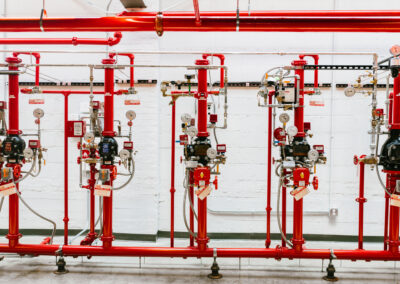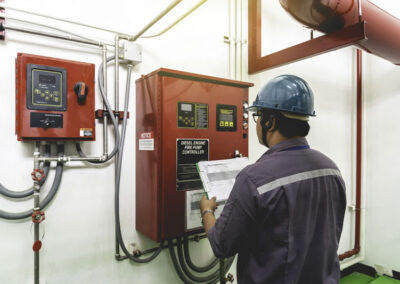What You Need To Know About Fire Alarms
A commercial fire alarm system is designed to detect and alert occupants of a building to the presence of smoke, fire, or other emergencies. Here is a basic overview of how it works and what it typically controls:
Components Of A Commercial Fire Alarm System
1. Smoke and Heat Detectors:
- Smoke Detectors: Sense the presence of smoke particles in the air.
- Heat Detectors: Detect a rapid rise in temperature or a predetermined fixed temperature.
2. Control Panel:
- Acts as the brain of the system, receiving signals from detectors and initiating appropriate responses.
- Monitors the status of various system components and provides diagnostic information.
3. Alarm Notification Devices:
- Audible Alarms: Sirens, bells, or horns that emit loud sounds to alert a building’s occupants.
- Visual Alarms: Strobe lights that provide a visual alert, which is particularly useful in noisy environments or for hearing-impaired individuals.
4. Manual Pull Stations:
- Allow individuals to manually trigger the alarm system in the event of an emergency.
5. Communication Systems:
- These can include voice evacuation systems that provide verbal instructions during an emergency.
How A Fire Alarm Works
Detection: When a smoke or heat detector senses a potential fire, it sends a signal to the control panel.
Verification: The control panel may cross-reference multiple detectors to reduce false alarms. Some systems can differentiate between actual fire conditions and non-emergency situations.
Notification: If the control panel confirms an emergency, it activates alarm notification devices throughout the building to alert occupants.
Response: The control panel may automatically notify the fire department or a monitoring service. It may also initiate other actions, such as unlocking exit doors or shutting down HVAC systems to prevent the spread of smoke.
Additional Fire Alarm Controls and Features:
Emergency Lighting: Ensures pathways are illuminated during an evacuation.
Elevator Control: Returns elevators to a designated floor and disables them in order to prevent use during a fire.
HVAC Control: Shuts down heating, ventilation, and air conditioning systems to prevent the spread of smoke and fire.
Door Release Mechanisms: Automatically unlocks doors to facilitate safe evacuation.
Sprinkler System Activation: Some fire alarm systems are integrated with sprinkler systems, triggering water flow in the event of a fire.
Monitoring Services: The system can be connected to a central monitoring station that oversees multiple locations, providing an additional layer of safety and quick emergency response.
Emergency Communication Systems: Public address systems can broadcast emergency instructions and updates.
Fire alarm systems are designed to be reliable, ensuring the safety of building occupants and minimizing property damage during a fire or other emergency situations. To learn more about your fire alarm and what it controls, register for Ryan Fireprotection’s free Lunch and Learn customer training event later this month.
________________________________________________________________________________________
Wondering what fire alarm system is best for your facility? We are ready to provide design, installation support, inspection, testing, and maintenance services. See what’s possible for your facility by contacting us today.


